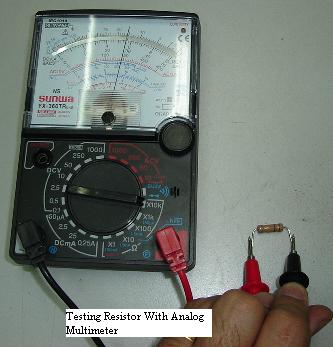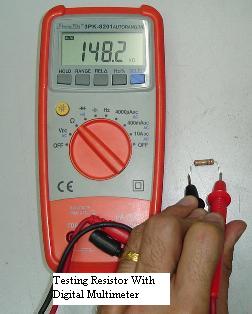Testing Resistor Using The Accurate Way
There are two ways to testing resistor such as using the analog and digital multimeter. Normally if a resistor fail they will either increase in value or open up at all (open circuit). You can check the resistor resistance with an ohmmeter or digital multimeter. If the resistor is in circuit, you will generally have to remove the resistor so you are testing only the resistor value and not the other components in the circuit. Always be aware of possible back(parallel circuit) circuits when checking an in-circuit resistance measurements.
As a technician, many times we wants to repair and solve electronic problems as fast as we could and by removing all resistors from the board and check the resistors one by one will take up a lot of our repair time. There must be a simple and easy way to test resistor on board. Using analog meter to check resistor on board often produced an inaccurate reading. This is due to the reasons that the output from the analog meter probe is about 3 volt to 12 volt. The voltages produced by the analog mater are quite high and it can trigger the semiconductor devices around the resistors circuit such as the diode, scr, transistor and ICs. Did you know that semiconductors devices needs only 0.6 volt in order to conduct? Since the output voltage from the analog meter is higher than the semiconductors, checking the resistor in circuit won't give you an accurate reading! In order to measure resistors while it is still in circuit, you need to get a multimeter that have the output of less than 0.6 volt.This is to avoid conducting the semiconductor devices around the circuit that you want to test. In my workshop i' m using the Greenlee digital meter that have output around 0.2 volt.
Though it cannot give me a 100% accurate reading at least it can help me to speed up my repair job. Why not 100%? This is due to that some electronic circuit have resistors that is directly parallel to each other. If you connect your digital multimeter leads across a resistor in a circuit and it measures higher than it should be, then you knows that the resistor is either open or has gone up in resistance. Other electronic circuit components cannot possibly increase the ohms value of a resistor; any parallel circuit could only make the resistance ohms reading lower. In some rare cases, sometimes a not discharge capacitor may caused the reading becomes higher than it should be. If you are a beginner i strongly recommend that you remove all the resistors leg (i mean only one leg) and test it with your digital meter. Learn the hard way first before jumping to test resistor on board. I just don't want a newbie to be confused about testing resistor. Once you grab hold of testing resistor off board then only you begin to check resistor on board. Hope with this secrets, checking resistor should not be a problem to you anymore.
Click here to get my FREE ebook and others quality electronic repair articles now!
|
|
Copyright@ 2006-2007-www.ElectronicRepairGuide.com All Rights Reserved



